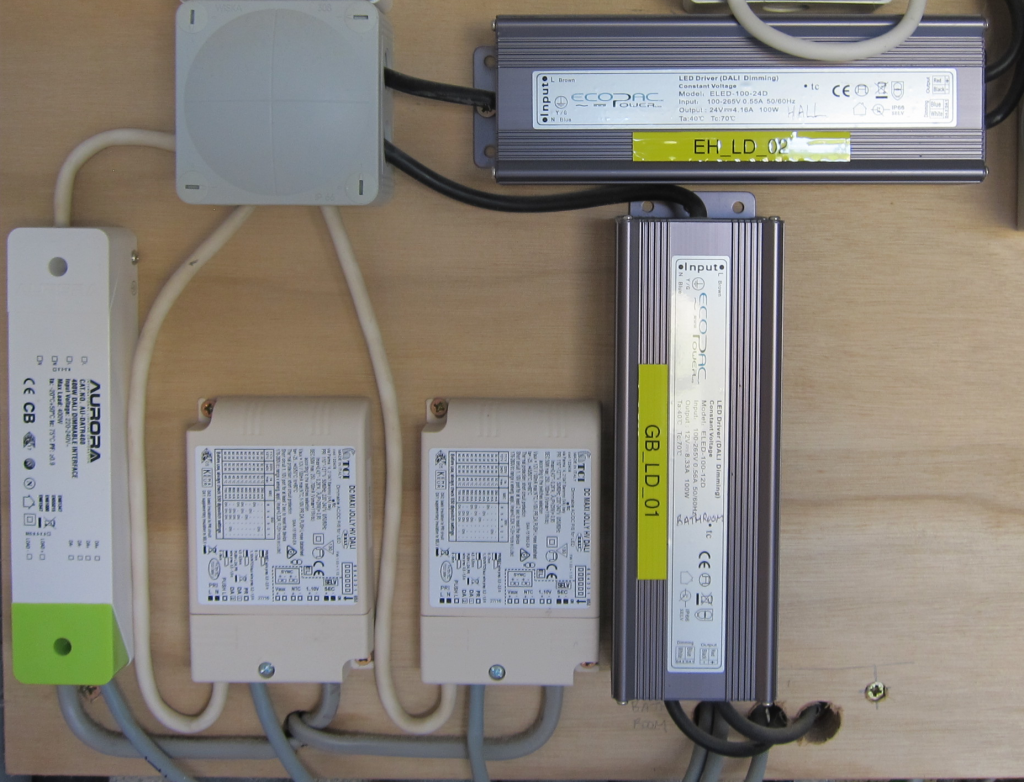The foundation of the Home Automation solution is a set of devices which conform to the KNX standard which is generally used in larger commercial or hospitality projects but which meets my requirements very well:
- When switching mains voltage the paramount requirement is electrical safety so it’s important to use commercially manufactured and certified devices
- There are a lot of competing, proprietary solutions on the market but I didn’t want to be reliant on any single manufacturer to offer a suitable range of devices (and integration options) and maintain those for the lifetime of the installation
- KNX is unusual (in a good way) in that it is not specific to one manufacturer and it’s normal to mix-and-match devices from different manufacturers within a single installation
- Many home automation solutions are intended to be add-ons to existing, ‘traditional’ electrical installations with hard-wired wall switches and light fittings – but in a new-build project there’s no reason to hard-wire anything
- If there’s no hard-wired switching for e.g. lights and blinds there’s also no fall-back in the event of problems with the home automation system – so it needs to be reliable
- KNX has a very robust ‘distributed’ system architecture with no central controller
- I wanted something that would be recognisable to home automation professionals, mostly from a resale standpoint (on the assumption that anyone buying the house would be less hands-on and would want to hand over any updates to the KNX control logic to a specialist)
In very high-level terms the KNX installation consists of a dedicated KNX ‘bus’ network using a specific type of twisted-pair wiring with various input and output devices mounted in electrical cabinets around the house.
While KNX is good for controlling many types of services it’s not ideal for lighting control. Native KNX dimmers are available but the choice is limited and they tend to be expensive whereas the alternative DALI standard is much more commonly used for dimmable lighting – and there’s a good choice of ‘gateway’ devices which bridge between the KNX and DALI standards so it’s not unusual to see both standards combined on one project. A DALI-KNX gateway presents all the DALI devices on the KNX bus so they look like KNX devices from a control standpoint, offering the best of both worlds.
The DALI standard is broadly equivalent to KNX in as much as:
- It is not owned by any single manufacturer and it is common to mix-and-max devices from different companies in one installation
- Communication is across a dedicated ‘bus’ network (separate from the KNX ‘bus’)
A good illustration of the flexibility of the DALI standard is shown in the photo below (a real example from the Utility Room). There are 5 different controllers of 3 different types:
- The white-and-green AURORA AU-DATR400 controller on the far left generates a dimmed 230V AC output suitable for table lamps with dimmable mains-voltage bulbs (connected via round-pin plugs; this one is for the circuit in the Dining Room)
- The two cream-coloured boxes with white labels are TCI DC MAXI JOLLY HV DALI controllers which generate constant-current DC outputs suitable for LED downlights
- The two grey boxes with silver labels are Ecopac ELED controllers which generate constant-voltage DC outputs suitable for LED tape striplights
- The one marked EH_LD_02 is a 100W, 24V unit for the recessed LED strip in the Entrance Hall
- The one marked GB_LD_01 is a 100W, 12V unit for the LED strip around the dropped-ceiling in the Ground-floor Bathroom (which is silicone-coated for protection from high humidity)

Mostly I am using KNX devices from German manufacturer MDT which I have found to be of high quality and with great functionality and documentation. A good supplier for these is eibmarkt in Germany.
KNX installations need to programmed with a Windows application called ETS which is firmly aimed at home automation professionals rather than end users. The full version, ETS Professional, is expensive but there is a cut-down version, ETS Lite, which is rather more affordable but can only be used with projects containing up to 20 KNX devices – which is actually just sufficient in my case.
(These days there is another option, ETS Inside, which is more intended for end users.)
There are a few further pages with specific configuration notes for some of the KNX devices:
![]() KNX and DALI by Marsh Flatts Farm Self Build Diary is licensed under a Creative Commons Attribution-ShareAlike 4.0 International License.
KNX and DALI by Marsh Flatts Farm Self Build Diary is licensed under a Creative Commons Attribution-ShareAlike 4.0 International License.
